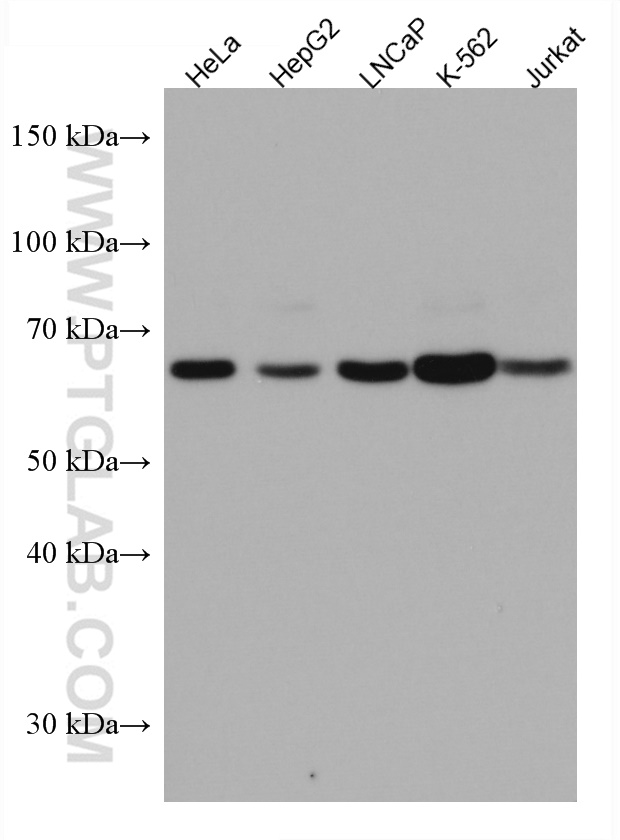验证数据展示
经过测试的应用
| Positive WB detected in | HeLa cells, HepG2 cells, LNCaP cells, K-562 cells, Jurkat cells |
推荐稀释比
| 应用 | 推荐稀释比 |
|---|---|
| Western Blot (WB) | WB : 1:1000-1:4000 |
| It is recommended that this reagent should be titrated in each testing system to obtain optimal results. | |
| Sample-dependent, Check data in validation data gallery. | |
产品信息
67318-1-Ig targets UBP1 in WB, ELISA applications and shows reactivity with Human samples.
| 经测试应用 | WB, ELISA Application Description |
| 经测试反应性 | Human |
| 免疫原 |
CatNo: Ag5010 Product name: Recombinant human UBP1 protein Source: e coli.-derived, PET28a Tag: 6*His Domain: 280-540 aa of BC047235 Sequence: IEDAVEHEQKKSSKRTLPADYGDSLAKRGSCSPWPDAPTAYVNNSPSPAPTFTSPQQSTCSVPDSNSSSPNHQGDGASQTSGEQIQPSATIQETQQWLLKNRFSSYTRLFSNFSGADLLKLTKEDLVQICGAADGIRLYNSLKSRSVRPRLTIYVCREQPSSTVLQGQQQAASSASENGSGAPYVYHAIYLEEMIASEVARKLALVFNIPLHQINQVYRQGPTGIHILVSDQMVQNFQDESCFLFSTVKAESSDGIHIILK 种属同源性预测 |
| 宿主/亚型 | Mouse / IgG1 |
| 抗体类别 | Monoclonal |
| 产品类型 | Antibody |
| 全称 | upstream binding protein 1 (LBP-1a) |
| 别名 | DKFZp686L1745, LBP 1a, LBP 1B, LBP1, LBP1A, LBP1B, Transcription factor LBP 1, UBP1, Upstream binding protein 1 |
| 计算分子量 | 60 kDa |
| 观测分子量 | 65-68 kDa |
| GenBank蛋白编号 | BC047235 |
| 基因名称 | UBP1 |
| Gene ID (NCBI) | 7342 |
| RRID | AB_2882578 |
| 偶联类型 | Unconjugated |
| 形式 | Liquid |
| 纯化方式 | Protein G purification |
| UNIPROT ID | Q9NZI7 |
| 储存缓冲液 | PBS with 0.02% sodium azide and 50% glycerol, pH 7.3. |
| 储存条件 | Store at -20°C. Stable for one year after shipment. Aliquoting is unnecessary for -20oC storage. |
背景介绍
UBP1, also known as Transcription factor LBP-1, is a 540 amino acid protein, which is expressed in adrenal tissue, JEG-3, NCI-H295A, Hep-G2 and HeLa cell lines. UBP1 localizes in nuclear and can be induced by HIV-1 infection of lymphocytes. UBP1 functions as a transcriptional activator in a promoter context-dependent manner and modulates the placental expression of CYP11A1. UBP1 is involved in regulation of the alpha-globin gene in erythroid cells and represses HIV-1 transcription by inhibiting the binding of TFIID to the TATA-box.
实验方案
| Product Specific Protocols | |
|---|---|
| WB protocol for UBP1 antibody 67318-1-Ig | Download protocol |
| Standard Protocols | |
|---|---|
| Click here to view our Standard Protocols |


